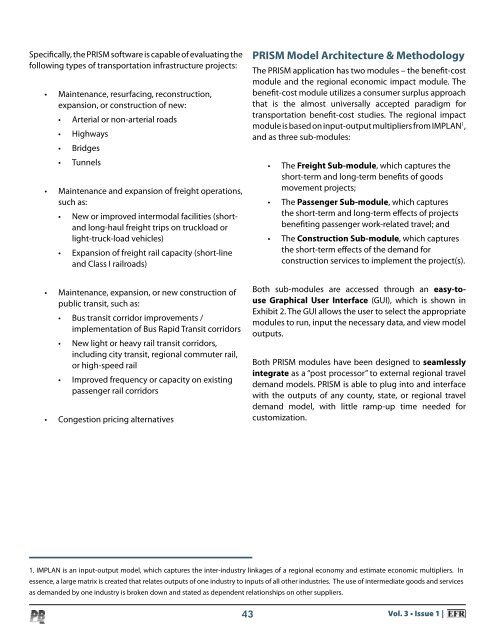Volume 3 Issue 1.indd - Parsons Brinckerhoff
Volume 3 Issue 1.indd - Parsons Brinckerhoff
Volume 3 Issue 1.indd - Parsons Brinckerhoff
You also want an ePaper? Increase the reach of your titles
YUMPU automatically turns print PDFs into web optimized ePapers that Google loves.
Specifically, the PRISM software is capable of evaluating the<br />
following types of transportation infrastructure projects:<br />
• Maintenance, resurfacing, reconstruction,<br />
expansion, or construction of new:<br />
• Arterial or non-arterial roads<br />
• Highways<br />
• Bridges<br />
• Tunnels<br />
• Maintenance and expansion of freight operations,<br />
such as:<br />
• New or improved intermodal facilities (shortand<br />
long-haul freight trips on truckload or<br />
light-truck-load vehicles)<br />
• Expansion of freight rail capacity (short-line<br />
and Class I railroads)<br />
PRISM Model Architecture & Methodology<br />
The PRISM application has two modules – the benefit-cost<br />
module and the regional economic impact module. The<br />
benefit-cost module utilizes a consumer surplus approach<br />
that is the almost universally accepted paradigm for<br />
transportation benefit-cost studies. The regional impact<br />
module is based on input-output multipliers from IMPLAN 1 ,<br />
and as three sub-modules:<br />
• The Freight Sub-module, which captures the<br />
short-term and long-term benefits of goods<br />
movement projects;<br />
• The Passenger Sub-module, which captures<br />
the short-term and long-term effects of projects<br />
benefiting passenger work-related travel; and<br />
• The Construction Sub-module, which captures<br />
the short-term effects of the demand for<br />
construction services to implement the project(s).<br />
• Maintenance, expansion, or new construction of<br />
public transit, such as:<br />
• Bus transit corridor improvements /<br />
implementation of Bus Rapid Transit corridors<br />
• New light or heavy rail transit corridors,<br />
including city transit, regional commuter rail,<br />
or high-speed rail<br />
• Improved frequency or capacity on existing<br />
passenger rail corridors<br />
• Congestion pricing alternatives<br />
Both sub-modules are accessed through an easy-touse<br />
Graphical User Interface (GUI), which is shown in<br />
Exhibit 2. The GUI allows the user to select the appropriate<br />
modules to run, input the necessary data, and view model<br />
outputs.<br />
Both PRISM modules have been designed to seamlessly<br />
integrate as a “post processor” to external regional travel<br />
demand models. PRISM is able to plug into and interface<br />
with the outputs of any county, state, or regional travel<br />
demand model, with little ramp-up time needed for<br />
customization.<br />
1. IMPLAN is an input-output model, which captures the inter-industry linkages of a regional economy and estimate economic multipliers. In<br />
essence, a large matrix is created that relates outputs of one industry to inputs of all other industries. The use of intermediate goods and services<br />
as demanded by one industry is broken down and stated as dependent relationships on other suppliers.<br />
43 Vol. 3 • <strong>Issue</strong> 1 |

















